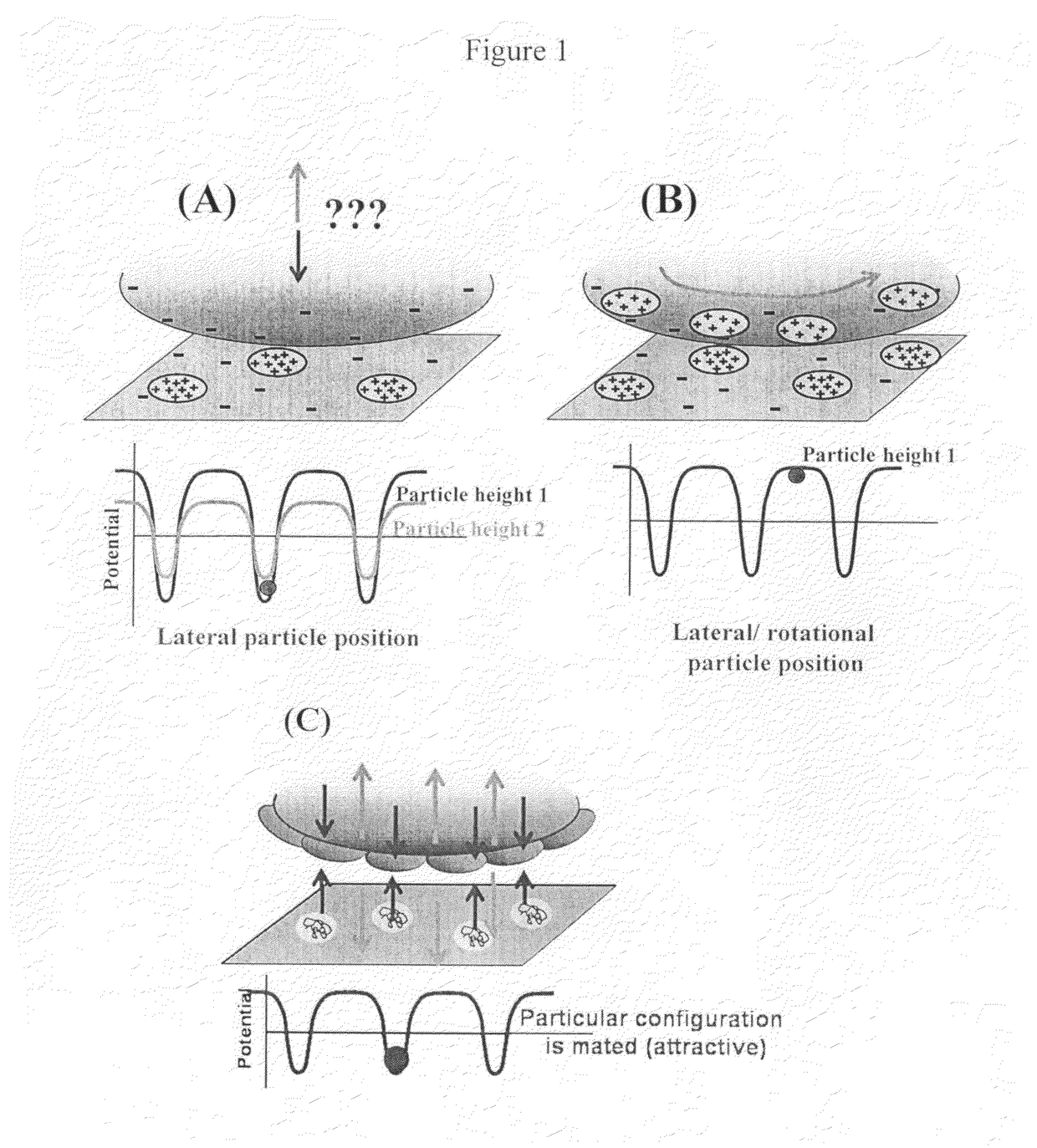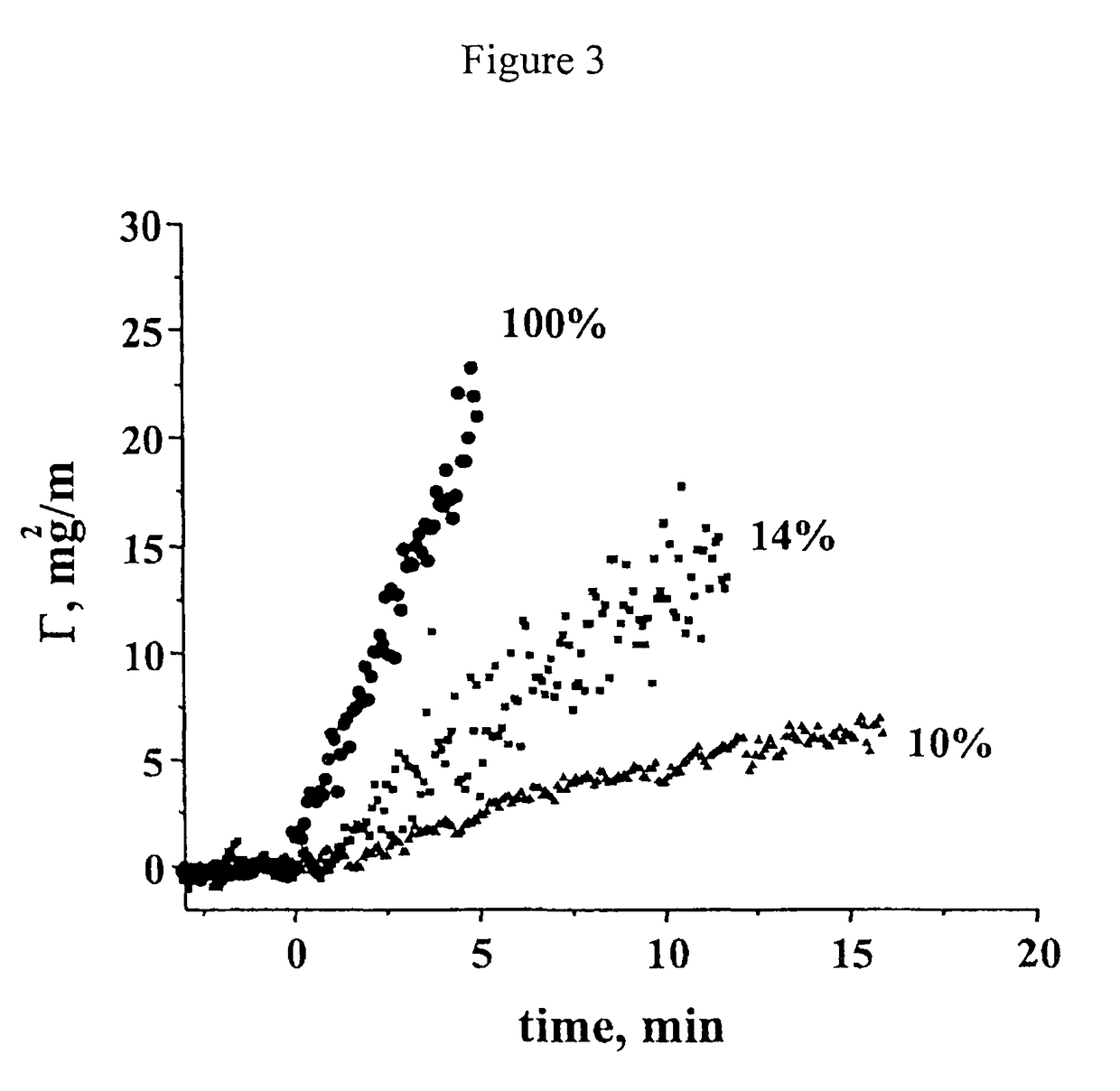Nanopatterned surfaces and related methods for selective adhesion, sensing and separation
a technology of nano-patterned surfaces and sensing, applied in chemical methods analysis, instruments, porous material analysis, etc., can solve the problems of high cost of production, high cost of surface chemistry, and labor or equipment costs, and achieve the effect of avoiding costly patterning technologies
- Summary
- Abstract
- Description
- Claims
- Application Information
AI Technical Summary
Benefits of technology
Problems solved by technology
Method used
Image
Examples
example 1a
[0082]Charge-wise-heterogeneous planar surfaces were generated by adsorbing varied amounts of pDMAEMA onto these silica surfaces from a 20 ppm flowing pH 6.1 buffered solution (at ionic strength, I=0.026M), using a laminar slit flow cell with a 10×40 mm slit machined into a black Teflon block and sealed against the microscope slide substrate using an o-ring. Continuous gentle flow (with wall shear rates in the range 10-50 s−1) maintained a constant bulk solution concentration and defined the mass-transport conditions. Saturated (completely positive and overcompensating the underlying silica substrate) surfaces were generated by allowing the pDMAEMA solution to flow over the surface for a few minutes longer than needed to saturate the surface. To generate heterogeneous surfaces, adsorption from gentle shearing flow was allowed to proceed only for a few seconds (a time which was systematically varied to tune the domain density) before the flow was switched back to pure buffer. Adsorbe...
example 1b
[0083]With reference to the preceding example, various other cationic polyelectrolytes can be physically adsorbed to a negatively charged surface, silica or otherwise, to provide other heterogeneous surfaces in accordance with this invention. Likewise, such charged components can undergo further chemistry for covalent attachment to such a surface member. Alternatively, spaced components comprising one or more available anionic polyelectrolytes can be employed on a positive surface member (e.g., a cationic self-assembled monolayer) for a reversed charge configuration. While planar silica slides were used as a negative surface member / substrate, the systems and methods of this invention can be employed with other oxide surfaces or, likewise, with non-planar surface / substrate configurations, for instance, the surfaces of fibers. For instance, a positively charged surface member can be constructed from a coating or monolayer of a material such as aminopropyltriethoxysilane coupled or app...
example 2
[0084]Monodisperse silica particles serve as an analyte, to exemplify the workings of the invention. Microscopy and optical reflectometry detection methods sense all silica particles utilized, while total internal reflectance fluorescence and fluorescence microscopy require fluorescent silica particles. In the case of fluorescent particles, they were synthesized such that a fluorescent dye resides in the core of the particle. The outer shell of the silica particle contains no dye and presents a pure silica surface (with negative charge) to the surrounding fluid. The fluorescent cores of some samples of particles allowed them to be distinguished from other, non-fluorescent particles that were added to the analyte suspension in some of the examples below.
[0085]To synthesize colloidal silica particles with fluorescent cores, a modified Stober process was used. (See, Vanblaaderen, A.; Vrij, A. Langmuir 1992, 8, 2921-2931; Stober, W.; Fink, A.; Bohn, E. Journal of Colloid and Interface S...
PUM
| Property | Measurement | Unit |
|---|---|---|
| distance | aaaaa | aaaaa |
| size | aaaaa | aaaaa |
| size | aaaaa | aaaaa |
Abstract
Description
Claims
Application Information
 Login to View More
Login to View More - R&D
- Intellectual Property
- Life Sciences
- Materials
- Tech Scout
- Unparalleled Data Quality
- Higher Quality Content
- 60% Fewer Hallucinations
Browse by: Latest US Patents, China's latest patents, Technical Efficacy Thesaurus, Application Domain, Technology Topic, Popular Technical Reports.
© 2025 PatSnap. All rights reserved.Legal|Privacy policy|Modern Slavery Act Transparency Statement|Sitemap|About US| Contact US: help@patsnap.com



